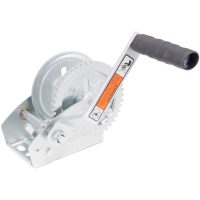
General Winch Selection Guidelines
Because the high forces generated when using a winch create potential safety hazards, careful consideration should be given to the winch selection process. Safety should be a primary concern and questions such as what winch features are required for the application, what will be the experience level of the user, and what harsh environmental conditions will exist, should all be answered. More specifically, an important first question should be, “Does the application require the freewheel feature – the ability to pull cable freely from the drum to attach it to the load – available in ratchet-type pulling winches?” If not, a self-locking type winch – brake winch or worm gear winch – should be used. Generally, ratchet-type pulling winches are not recommended for lifting applications, and their use should be limited to horizontal or incline pulling operations requiring a freewheeling feature.
The experience or skill of the intended user is also important. For example, self-locking brake or worm gear type winches should generally be selected for rental equipment, even if the lack of a freewheel feature will make the operation slower or more cumbersome. This is because rental equipment will frequently be used by inexperienced operators unfamiliar with the safe use of the product, and self-locking winches reduce the skill and understanding necessary to operate a winch safely.
If the winch is likely to be used in a harsh environment, including such things as salt water, a potential for damage or abuse of the winch, or the likelihood of little or no periodic maintenance, then this should be factored into the winch selection. A larger size winch should possibly be selected, or guards on the product using the winch should be provided to protect the winch from damage or abuse.
It is sometimes difficult to determine the amount of load being pulled with a winch. All D-L hand winches are designed to pull their rated capacity with a force on the handle in the approximate range of 35 to 55 lbs. This means that the winch should be able to be cranked easily with one hand. If not, it is probably overloaded.
D-L winches are not designed to be used as hoists for lifting, supporting, or transporting people, or for loads over areas where people could be present. D-L winches are built to high quality standards, but do not include the features necessary to make them appropriate for moving humans or overhead hoisting applications.
Boat Weight To Winch Capacity Ratio
A commonly used ratio of boat size to winch capacity is 2 to 1. Example: a 2,200 lb boat requires a 1,100 lb winch. There are, however, many factors to consider in selecting the proper size winch which are beyond the control of the winch manufacturer. For example, the ratio can sometimes be stretched to 3 to 1 when using a trailer equipped with good quality free-turning rollers maintained in excellent condition and most commonly used on ramps where the boat floats most of the way onto the trailer. The ratio should be reduced to as much as 1 to 1 on trailers using wooden bunks with no self-alignment capabilities, most frequently used on boat ramps requiring that the boat be winched a long way onto the trailer. Note that pontoon boat trailers and other special designs require special consideration to winch capacity selection.
Rolling Load Capacity
To calculate the rolling load capacity of a winch – the amount of load that can be pulled up an incline – multiply the winch capacity by the factor shown in the chart. The multiplication factor shown includes a 10% rolling friction factor. Note: 5% incline is a 1/2 ft. rise in 10 ft.
| % Incline | Multiply By |
|---|---|
| Level Surface | 10.0 |
| 5 (3°) | 6.67 |
| 10 (6°) | 5.02 |
| 20 (11°) | 3.40 |
| 30 (17°) | 2.61 |
| 50 (26°) | 1.86 |
| 70 (35°) | 1.53 |
| 100 (45°) | 1.29 |

